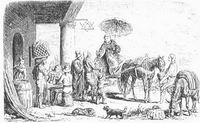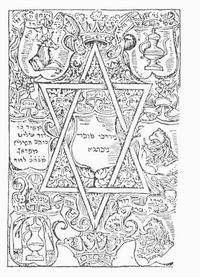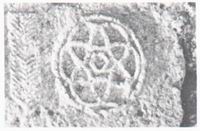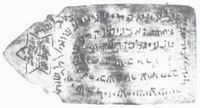Historical depictions, guild signs and symbols of the brewing and malting handcraft
Tapping signs
Many brewer emblems and symbols contain in addition to the classic tools like malt scoop, mash fork and beer tumbler also the hexagram (six pointed star), the so called beer or brewing star, which in literature is often referred to as oldest guild emblem of brewers [66] .
Abb. 19: Faßboden
mit Hexagramm
und Zunftwappen,
Internetbildsuche, Google
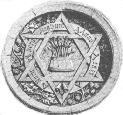
Furthermore the hexagram can be found as tapping sign for taverns.
Abb. 21: Gastwirtschaftsausleger
mit Brauerstern,
in Ursula Pfistermeister, S. 34
Abb. 22: Wirtshaus
in Nürnberg, Anfang des 20. Jahrhunderts,
in Der Davidstern, S. 105
Abb. 23: Wirtshaus
auf dem Weg von Oaria nach Mailand,
in Der Davidstern, S. 104
The right to tap beer was in the middle age often combined with the brewing right [67] . Nürnberg had a very strict rule: Only breweries were allowed to tap beer or sell in barrels directly to customers. Brew taps as regular taverns did not exist until 1540 [68] . A similar regulation was applied in Cologne (Köln) [69] .
To indicate to (potential) customers where food and drink was available, houses needed to be marked with distinct symbols - as will be shown later, not only the hexagram was used. Before discussing these symbols in detail, the origin of commercial hospitality must be looked at.
4.1 History of gastronomy
Having a selection of hotels and taverns in a city is today self-evident. Both are regarded as services which have to payed for. Looking back in history reveals, that this used to be different.
The old german tribes did not know commercial gastronomy. Private (free) hospitality was an upmost duty within the community [70] . In this context one has to realize however, that travelling in those times was quite uncommon and scarce. With the conquest by the Roman Empire and the hence introduced extensive and safe road network, the amount of travellers increased. Christian believe - the last heritage of the Romans Emperors - brought new reasons for travelling: Pilgrimage to the Holy Land. (Free) catering and accomodation of palmers would have overwhelmed the people who lived at the main roads [71] , and hence from the 5th century onwards monasteries and other churchly institutions took over this duty: The religious hospitality [72] . The resolutions of the 4th council of Carthago in 398 A.D. bound bishops to provide hospices at churches [73] .
With the rise of the cities, the crusades in the 11th century and the newly formed long distance trade yet more change came about Europe [74] . Settlements had increasing demand for catering and accomodation of (trade) travellers. This could neither be rendered by monasteries nor private households: Hence the commercial hospitality was formed [75] . One of the oldest tavern concession can be found in the Pax Bavaria from 1244 A.D. [76] .
The transition from private to commercial hospitality went probably fluently - the two forms coexisted most likely for a long time parallel. The cities provided every citizen originally with a general right for brewing and tapping beer and wine. As they soon realized, that money could be made with this, the amount of private taps increased quickly. Both commercial brewers and city leaders obviously could not tolerate this development - the former lost customers, the latter lost taxes. Hence from the 14th century on many city councils issued laws which limited or even forbade private tapping and private brewing.
Marking of houses in todays sense is relatively new: Streetnames
and house numbers were introduced in large parts of Europe only be the end of
the 18th century
[77]
. The usage of symbols to indicate hospices and taverns is
however older: Tap signs were already implented by the Greeks
[78]
. As many people could not read in those times, easy to interpret
symbols were the obvious choice. The following chapter will give an overview
on these various signs.
4.2 Overview of various tapping signs
The earliest symbols had reference to the tapped beverage. Wine taverns used vine branches and beer taverns grian spikes. With some interpretation one could imagine such a spike in the hexagram of the Herttel Pyrprew picture. In the course of time, these beverage-specific branches became general branches or bunches and bushes, which were mounted on a pole over the entrace of the tavern [79] . Todays german expression "Straußenwirtschaft" (bunch tavern) probably derives from this developement.
Abb. 24: Nüssel
Weinschenk,
Mendel (1425-1436), 21v
Above Nüssel a bunch or branch respectively is mounted on a pole as sign for wine tapping. Below an emblem, which probably indicated the origin of the wine. In general it is interesting to note, that within the house book of the Mendel endowment tapping signs can be found with wine tappers and brewers, but not with innkepers. The following picture of a wheat beer innkeper may serve as example:
Abb. 25: Konrad
Haußner, Weizenbierwirt,
Mendel, Band II, 181v
This phenomenon might be explained with the fact, that all other profession, i.e. the weavers [80] , did not bear any symbols either. Only wine tappers, brewers and doctors have insignia - maybe because all these were relevant for the health of citizens and hence underwent stronger control by the city council. The symbolic might not indicate the pride of the craft, but rather a special observation by the city. In image 26 can be seen, that however in much later years, the star can also be found with innkepers.
Abb. 26: Zunftzeichen
der Wirte,
in Alfred Grenser, Tafel 28
Similar to branch and bunch is the wreath from image 27, which mostly indicated wine tappings [81] , but sometims also beer tappings [82] . A very special rule can be found in Landshut: There the beer price determined whether to use birch or circlet as tapping sign [83] . Birch, or trees in general were not only used in Landshut, but quite common as tapping sign [84] .
The wreath developed over time into the circlet from image 28 as standard sign of hospitality (not only wine tapping). The first circlet might have been formed by the fading of such a wreath.
Abb. 28: Gastwirt
empfängt seine Gäste,
1467, Karl-S. Kramer S. 104
A simplification of above described signs can be found in England: The ale-pole [85] . As rudimentary leftover only the pole remains without sign. A smiliar institution exist in Germany: The so called "Besenwirtschaft" (broom tavern).
Abb. 29: Ale-pole
aus England,
aus dem Internet von Brian A. Nummer
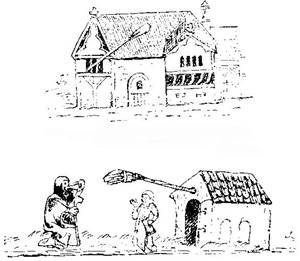
Another custom has been passed on from Straßburg: To indicate the tapping of beer a chair was put in front of the house [86] , and in addition there were barkers [87] .
A special tapping sign comes from Nürnberg: Ouch sol ein iclich pierprew, waz er piers preut, selber mit offem hause und mit auzzgestossem gattern verschenken [88] . This grid (or gate) can be seen in image 8 above Jorg Premaister on a pole. Next to it a ausgeregeter, sichtiger zeiger [.], daran verständig gemacht, wie tewer das pier geschenkt [89] (visible beer indicator). Martin Engelbrecht draws this indicator in his copper engraving from 1730 as a hexagram.
Abb. 30: Ein
Bierpreü, Augsburg 1730,
Martin Engelbrecht, in Bier in Nürnberg-Fürth,
S. 12
An early mentioning, yet however no depiction, of this "Bierzeiger" (beer indicator) stems from Regensburg at the beginning of the 14th century in a court protocol between city and clerus on the matter of beer taxation: [.] die reichsstiftischen Bierbrauer fingen schon an, Bierzeigl (das Schenkzeichen) anzustecken [..] [90] . This proves, that not only civic brewers, but also churchly brewers were using the Bierzeiger as symbol. As in later depictions this Bierzeiger is always drawn as hexagram, it is safe to say, that the clerus also used the six pointed star as beer indicator. However, the final proof in form of a depiction was unfortunately not found in the course of research for this thesis.
The term Bierzeiger lives on until today: In the Oberpfalz (mid eastern part of Bavaria) there is the tradition of Zoiglbeer, a form of municipal brewing right, in which every house owner is allowed to brew and indicated this with a "Bierzoigl" (local dialect expression for Bierzeiger) [91] .
Abb. 31: Bierzoigl
aus der Oberpfalz,
aus dem Internet, Zoigl-Heimat
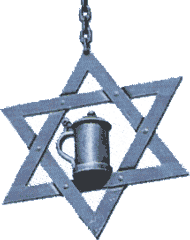
A similar tradition survived in the area around Pegnitz (near Nürnberg): The "Flindern". Here a branch is used as symbol for beer tapping [92] .
The brewing star in Nürnberg was either red or white, to indicate the tapping of red or white beer [93] . Image 9 of Distler Albrecht displays in the background a red hexagram and a branch. This double indication is quite unusual, as mixed tapping (beer and wine) was normally not allowed. In rare single cases the city council granted wine tappers the permissions to serve beer from outside town (in this case red beer) [94] . This assumption is supported for one by text above the image: Hans Albrecht sonst Distler genannt ain preumaister des pierpreu handels [.]. (Hans Albrecht Distler, a brewmaster and beer trader ...) and for the other by the fact, that no brewing tools are shown for Distler. In addition, the background of the image appears to be rural, so maybe outside the Nürnberg city wall.
The matter becomes somewhat unclear, as the first official ruling of the city council on non-Nürnberg beers is from 1561, but Distler had died in 1560. However it is quite concieveable that "alien beer" was tapped before that time, i.e. in the time of summer, when the Nürnberg breweries could not supply enough beer for the higher demand of the citizens.
Most of above described symbols have vanished and are no longer part of modern tavern anchors. The brewing star is a different issue, as it can be found today in many places in southern Germany [95] . Hence the following chapter will have a closer look on this development.
4.3 A mystery: The hexagram
The brewing star - a six pointed hexagram - is today perceived not as beer symbol, but as jewish sign. Like the crucifix for Christians, the Star of David or Magen David (Shield of David) is today the symbol for an entire religion. How could one symbol in the course of history get two so different meanings? Might there even be a connection between both form, e.g. do they have the same origin, or is the similarity merely coincidental?
4.3.1 History of the Star of David
The history of Judaism has been very well covered in research and literature and much material can be found. The origin of the star and its first "pure jewish" usage is hereby subject to a quite controversial debate. It has been confirmed, that the jewish community of Prague did have a hexagram as symbol in mid 14th century. The reason can be found in mideval city structure: Citizens had to defend their settlement against aggressors from outside. Every quarter would have its own militia and had to defend "its" city gate and Jews often had their own gate - the "Jewgate" [96] . Prague had a similar situation and hence there was a jewish militia. Emperor Karl IV, who was in favor of Jews (quite uncommon in these days), granted this milita the right to bear their own flag - the first one was probably donated by himself. Diese Fahne ist der erste Beleg der von der magischen Überlieferung genährten Verwendung des Hexagramms als politisches Zeichen einer jüdischen Gemeinde (This flag is the first proof of [...] usage of the hexagram a s a political symbol) [97] .
In addition, Prague was a center of hebrew letterpress. As symbol and signet the hexgram can first be found in 1492 [98] .
Abb. 33: Druckerzeichen
von Mordechai Sopher,
Prag 1512, in Der Davidstern, S. 74
Bohemia was at the time the only region in Europe, where Jews were not forced to wear any insignia or special clothing, which set them apart from the rest of the (christian) population [99] . Maybe this relativly high tolerance and freedom for the Jews and the hence well developed jewish self confidence added to the later spreading of the hexgram as jewish symbol all over the world. The europe wide connections of the Prague printers and the distribution of Prague hebrew books probably had their share in this development, too. The "breakthrough" for the hexagram as jewish symbol was the zionistic movement in the late 19th century. The holocaust in WWII finally gave the star of david its religious and unifying properties and hence it has replaced in this respect the Menora (seven armed candleholder from old testament). [100] .
4.3.2 Origin and antique meaning of the hexagram [101]
The history of the hexagram begisn long before the 14th century. There are two basic senses to it:
One the one hand it symbolises like the chinese Ying and Yang the opposites of nature, for instance god and evil or fire and water in alchemy. On the other hand the hexagram had relevance as protection symbol and talisman on amulets or houses.
It can be found on a signet from 7th century B.C. in Sidon and with the Templar [102] . One of the oldest depictions was in Beth-El (image 34) near todays Ramallah (now world wide well know through the palestine conflict). Whether is was regarded as jewish symbol in those days, can not quite be determined today, however, as many other symbols are found in the vicinity, it is obvious that the hexagram was not THE representing symbol for Judaism in that epoche [103] . The function as protection symbol dominates in those early findings.
Abb. 34: Zeichen
an einem Gebäude in Beth-El,
ca. 3. Jahrhundert v.Chr., in Asher
Eder, S. 10
In indian Hinduism, in the tantric legends from 8th century B.C. to be exact, depictions of the hexgram can found symbolising the antagonism, but also connection between man and woman [104] .
The Egyptians used the symbol for communicating with the dead and from these rites the catholic church later derived a protection from demons. The builder of the pyramids were also the first to use the hexagram - as well as the five pointed pentagram - as safeguard symbol for house and stove (image 35).
Abb. 35: Silberne
Amulette als Glücksbringer,
in Der Davistern, S. 23
Later the hexagram can be found in the arabic world. It is ornament in art and alchemistic symbol [105] . Alchemy is predecessor of todays chemistry. It had developed from various teachings of Greeks and Egyptians and was adapted from the 4th century A.D. on by the Arabs [106] . The brought it in 711 in the course of their conquests to Spain and hence to Europe. From there the mideval alchemy spread over the continent, with its goal of turning basic into precious metals (i.e. iron to gold). For alchemy the two superimposed triangles of the hexagram stood for fire and water.
The jewish Kabbala at the end of the first millenium is based and the arabic alchemy and it turn has itself a big influence on christian alchemy, which lead to a synonymous usage of both terms in the 16th century.
In this context it is often argued, that brewers and alchemists were very much alike as both would "stir in kettles" and work with fire and water and produce a brew and hence it would be obvious, that brewers would adapt the alchemistic hexagram as their symbol [107] . Whether this is the only and true explanation for the six pointed star as brewing star will be analysed further in the next chapter.
The jewish kabbala very likey contributed to the distribution of the hexagram into and in Europe. Jews in early Islam very well regarded and had an extensive network between the orient and the occident through trade, historic roots and families [108] . One of the earliest depictions of the six pointed star can be found in the Pentateuch-Codex of Leningrad from 1009 [109] .
In the middle age both hexagram and pentagram were used as mystic symbols, like in egyptian times, as protection against demons, weapons, fire or bad luck in general [110] . The symbols were edged in door frames or door steps. The early associations of chiselers (in german: Loge) used the hexagram as their symbol [111] , continued in modern times by the freemasons [112] . The symbol can also be found on various jewish institutions, for instance on a column of the first synagoge in Nürnberg (built 1296) [113] .
The simultaneous and synomymous usage - sometimes by mistake, sometimes on purpose - of five and six pointed star can be found all throughout history [114] . Even the modern internet is not immune to these errors: Entering "hexagram" in a picture search engine, such as Google [115] will result in almost as many five as six pointed stars.
There is an intriguing connection between hexagram and military fortification and defense techniques. A line in form of a sexangle, i.e. a city wall, is most effective in battle and hence has been and is being used often in past and present [116] - maybe one of the reasons for the use of the hexagram as protection symbol.
4.3.3 Why the hexagram as brewing sign?
As mentioned earlier, literature often describes the brewing star as alchemistic symbol, which symbolises the for brewing necessary elements [117] . However it seems unlikely that at the general low level of education in mideval times [118] brewers would have known about the alchemistic significance of the hexagram. In addition, brewing used to be a duty of women and were then adapted by monks and later tradesmen in the city. As described earlier, the clerus had used the beersign in Regensburg as tapping sign. It is highly unlikely that monks would use alchemistic symbols for anything, especially so as Pope Johannes XXII condemned alchemy in 1317 [119] .
Moreover, alchemy existed all over Germany, while the brewing star can in this form only be found in franconia and nothern bavaria. Furthermore the question arises, how the not very well regarded and by the church pursuited alchemists suddenly could have become accepted brewers in cities and even council members. Last but not least the comparison between brewing beer (turn water into beer) and alchemists (turn crude metal into precious metal) is somewhat strange from a mideval point of view: Beer was - other than wine - not a precious drink, but everyday nuritment for commoners.
All combined, the theories on the connection between alchemy and brewing seem to based largely on superficial, modern assumptions. But what other reasons could have lead to the usage of the hexagram as brewing symbol?
A possible answer to this question could be found in the second meaning of the hexagram: Its usage as protection symbol [120] . As described earlier, the hexagram in mideval times a sign against bad luck, demons, weapons and fire. The shielding of demons was - because of the in chapter 2.1 described misconseption - quite important for brewers, and also the need to avert combustion. Hazardous fires are reported frequently in malt houses and breweries [121] . The sexangle can hence also be found in the emblems of other crafts which were confronted with fire, such as chimney sweepers [122] . In addition, the Jews were also familiar with the hexagram as fire protection symbol [123] .
Abb. 36: Zunftzeichen
der Schornsteinfeger aus Dresden,
in Alfred Grenser, Tafel 11
The interpretation of the hexagram as fire protection symbol can be further confirmed in Nürnberg: At the end of day the closing of taverns was indicated by ringing the fire bell. In other cities this happend trough barkers and beer bells (much like the "last orders bell" in England today) [124] .
Moreover, in image 8 of Jorg Prewmaister we see the grid as tapping sign. Other than between branches and wine, there is no obvious connection between grid and beer. If we look at the patron of the franconian brewers, the holy Laurentius, who also should protect them from fire [125] , a possible connection can be postulated: Laurentius was a christian martyr, who was roasted to death on a grill (hence grid) by Emperor Valerian in 258 A.D., as he would not give away the location of the church treasure of Pope Sixtus. Maybe the grid is a symbol for Laurentius and hence a protection against fire.
All this would also explain, why star and grid, different from other guild symbols like mash fork, malt scoop and beer tumbler, did not became commen all across Germany: Fire safety was handled differently in every city and Laurentius was not everywhere the patron of brewers [126] .
In conclusion there are quite some indications, that the hexagram might not have been an alchemistic symbol, but rather a protection symbol against fire and demons.
4.3.4 Jewish star and brewing star, an independet development?
The question of a possible connection between Jew- and Brewstar has been dealt with by Peter Freimark in "Davidschild und Brauerstern, Zur Synonomie eines Symbols". He arrives at the conclusion that die einzige Gemeinsamkeit des Symbols [.] die Herkunft aus dem böhmisch / mährisch / fränkischen Raum [127] (the only commonalty is the origin in franconia / bohemia) and that anything further was separate and independet.
The previous chapter of this thesis revealed, that the hexagram came from the orient to Europe and Jews have had significant part in this development. Furthermore it has been shown that the hexagram
- was used for the first time as explicitly jewish sign in Prague in 1350 on the flag of the jewish milita
- appears as brewing sign for the first time in Nürnberg in 1425
Apart from the spacial there is also a timely proximity of the first origin. Moreover both symbols derive from a common base in the orient. Might there be a connection between the two, despite of the remarks of Peter Freimark?
Nürnberg, as a free city, was subordinated directly to the Emperor. It wasn't until 1806 that Nürnberg became a part of Bavaria and lost its independence. Relevant for Nürnberg was hence only the will of the Emperor, and he reigned from 14th century on in Prague. The Jews as "Kammerknecht" were also direct subjects of the Emperor and were (at least on paper) protected by him. For this they payed a Judensteuer (jew tax) to him. The Emperor in turn often lend this tax to dukes or city councils, and this was the case in Nürnberg. The city payed a fix sum of 400 gulden to the Emperor [128] . From the family Mendel, the founders of the twelve brother's endowment, it has been passed on, that they brought this fee on several occasions to Prague [129] .
So there were strong relations between Prague and Nürnberg. It is conceivable that this also influenced everyday life and culture of both cities. Even today Prague is in regards to architecture much more similar to Regenbsurg, Bamberg or pre-war Nürnberg, than north german or slawik cities. As there was a Jew pogrom in the middle of 14th century, it is likely, that jewish residents of Nürnberg would have fled to their fellow believers in Prague, and in turn brought their habits and customs with them, and hence influenced the jewish community in Prague.
In conclusion it appears possible that on the basis of above stated facts the hexagram was in those days in Franconia and northern Bavaria widely used symbol for protection and in this form used by everyone including both jews and brewers [130] . The exiled jews of Nürnberg brought the star with them to Prague, where it became symbol of the jewish community and was then spread all over the world through letterpress. The brewing star remained however in south Germany and developed into a tapping sign.
| previous chapter |
[66] Literaturverzeichnis: Freiberger Altertumsverein, S. 35
[67] Literaturverzeichnis: Werner Schultheiß, S. 154; Einer der ältesten Bierschänken findet sich in Bamberg im Jahre 1093 (Freiberger Altertumsverein, S. 41)
[68] Literaturverzeichnis: Nürnberger Satzungsbücher, S. 154 ebenso Walter Grönert S. 12 f ebenso Bier in Nürnberg-Fürth S. 8; Eine interessante Anmerkung steht bei Walter Grönert: So war das Bier - anders als Wein - um 1300 in Nürnberg noch steuerfrei! Genauso laut Karin Hackel-Stehr bis 1310 in Regensburg.
[69] Literaturverzeichnis: Johanna Kachel, S. 54-55
[70] Literaturverzeichnis: Johanna Kachel, S. 7 ff
[71] Literaturverzeichnis: Hans Conrad Peyer, S. 2-3
[72] Literaturverzeichnis: Kulturgeschichte der deutschen Gaststätte, S. 2 ff
[73] Literaturverzeichnis: Walter Grönert, S. 2
[74] Literaturverzeichnis: Hans Conrad Peyer, S. 8
[75] Literaturverzeichnis: Walter Grönert, S. 3
[76] Literaturverzeichnis: Kulturgeschichte der deutschen Gaststätte, S. 11
[77] Literaturverzeichnis: Kulturgeschichte der deutschen Gaststätte, S. 73
[78]
Literaturverzeichnis: Ursula Pfistermeister, S. 6-7
ebenso Kulturgeschichte der deutschen
Gaststätte, S. 73 ff
[79] Literaturverzeichnis: Hans Conrad Preyer, S. 23
[80] siehe Abbildung 9
[81] Literaturverzeichnis: Johanna Kachel, S. 169-170
[82] Literaturverzeichnis: Wilhelm Scheben, S. 54
[83] Literaturverzeichnis: Karin Hackel-Stehr, S. 94
[84] Literaturverzeichnis: Karl-S. Kramer, S. 103
[85] Internetverzeichnis: Brian A. Nummer
[86] Literaturverzeichnis: Johanna Kachel, S. 170
[87] Literaturverzeichnis: Kulturgeschichte der deutschen Gaststätte, S. 12
[88] Literaturverzeichnis: Nürnberger Satzungsbücher, S. 267
[89] Literaturverzeichnis: Werner Schultheiß, S. 77
[90] Literaturverzeichnis: Karin Hackel-Stehr, S. 157
[91] Internetverzeichnis: Zoigl-Heimat
[92] Internetverzeichnis: Brauer-Vereinigung Pegnitz GmbH
[93] Literaturverzeichnis: Werner Schultheiß, S. 77; ebenso Walter Grönert, S. 55
[94] Literaturverzeichnis: Walter Grönert, S. 58
[95] siehe Abbildung 21
[96] Literaturverzeichnis: Georg Caro
[97] Literaturverzeichnis: Der Davidstern, S. 70 ff
[98] Literaturverzeichnis: Der Davidstern, S. 74
[99] Literaturverzeichnis: Der Davidstern, S. 62-63
[100] Literaturverzeichnis: Jüdisches Lexikon, S. 1282
[101] Eine weitere, nicht selbstverfasste Übersicht befindet sich als Anhang auf der dieser Arbeit beigefügten CD.
[102] Literaturverzeichnis: Der Davidstern, S. 19
[103] Literaturverzeichnis: Asher Eder, S. 11
[104] Literaturverzeichnis: Asher Eder, S. 21-23
[105] Literaturverzeichnis: Jüdisches Lexikon, S. 1282
[106]
Der Begriff Al'kohol ist beispielsweise ein arabischer
Ausdruck.
Siehe Internetverzeichnis: Prof. Dr. H. Rusam
[107] Literaturverzeichnis: Ursula Pfistermeister, S. 80
[108] Literaturverzeichnis: Georg Caro
[109] Literaturverzeichnis: Der Davidstern, S. 28-29
[110] Literaturverzeichnis: Gerbern S. Oegema, in Der Davidstern, S. 18-19
[111] Internetverzeichnis: Beatrice Przegendza
[112] Internetverzeichnis: Kurt Schrage
[113] Internetverzeichnis: Prof. Dr. H. Rusam
[114] Literaturverzeichnis: K. v. Jezewski
[115] zum Beispiel: http://www.google.de
[116]
In der deutschen Bundeswehr findet diese Prinzip nach wie
vor Einsatz: AnwFE 212/100 Absatz 1707, Absatz 1819 sowie
Anlage 16
[117] Literaturverzeichnis: Der Davidstern
[118] oder das Fehlen desselben
[119] Internetverzeichnis: Chemieplanet
[120] Vgl. vorheriges Kapitel
[121] Literaturverzeichnis: Walter Grönert, S. 51, ebenso Karin Hackel-Stehr, S. 134
[122] Der Patron der Schornsteinfeger ist übrigens der heilige Florian - ein weitere Feuerschützer. Er ist heute zusammen mit dem hl. Laurentius Patron der Feuerwehr.
[123] Literaturverzeichnis: Johann Jakob Schudt, S. 75-77
[124] Literaturverzeichnis: Kulturgeschichte der deutschen Gaststätte, S. 26-27
[125] Vgl. Kapitel 2.4
[126] Literaturverzeichnis: Alfred Grenser, S. 22
[127] Literaturverzeichnis: Festgabe für Hans-Rudolf Singer, S. 647
[128] Literaturverzeichnis: Emil Reicke, S. 233
[129] Literaturverzeichnis: Faksimile Mendelsches Hausbuch, S. 63
[130] In Fürth, das älter als Nürnberg ist, durften Juden sogar Bier brauen. Zudem gab es in der Region einen florierenden Hopfenhandel, der von den Juden dominiert wurde. Die direkteste Vermutung, daß Herttel nämlich Jude gewesen sein könnte, kann allerdings ausgeschlossen werden. Zum einen durften in Nürnberg Juden nicht brauen, zum anderen waren sie auch sicherlich nicht in dem Bruderhaus zugelassen, da sie kein Nürnberger Bürgerrecht hatten.


